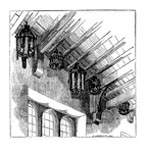
Beyond Balkanization
CROATIA & ITS CARDINAL
Zagreb is the capital of Croatia, one of the primary nations of the Balkan Peninsula in southeastern Europe. It is a tricky business for a visitor to make sense of the Balkans. It seems like a beautiful, civil, prosperous, and culturally alive place. Croatia became an independent nation-state in 1991, having formerly been a province of communist Yugoslavia. Outside Zagreb’s airport is a statue of Franjo Tuđman, Croatia’s founding president. My taxi driver explains that of course Tuđman was a corrupt politician; what more would you expect? Yet Tuđman won the war for independence, converted Croatia to a free-market economy, and revived Advent as a national holiday, making Zagreb’s Advent festival supposedly the largest in Europe. It is quite a change from the atheistic communism Croatia endured during the preceding five decades. Croatia is now a member of both the European Union and the NATO military alliance.
This is Croatia’s second round of independence in modern times. During World War II, it broke from Yugoslavia as a Nazi puppet state. Before then, Croatia was a province of Yugoslavia, which was itself a kingdom. Yugoslavia was founded in the aftermath of World War I as a homeland for multiple southern Slav ethnicities. Prior to World War I, the territory of Croatia was part of the Austro-Hungarian Empire. Before then, for centuries, most of its land was ruled by Muslim Turks of the Ottoman Empire.
By my count, in the century preceding my 2019 visit, Croatia had four of its governments overthrown, was a battlefield in three major wars, and was fractured socially across three ethnicities — Croats, Serbs, and Bosniaks — who were further divided by religion — Roman Catholicism, Eastern Orthodoxy, and Islam, respectively. Such torments have made the term Balkanization a part of the English language. The Encyclopædia Britannica defines it as “the division of a multinational state into smaller ethnically homogeneous entities,” “ethnic conflict within multiethnic states,” and “disintegration into dictatorship, ethnic cleansing, and civil war.” What was striking to me as an American is that all three ethnicities speak essentially the same language and are indistinguishable in appearance.
To a tourist visiting Zagreb today, Balkanization seems invisible. State-of-the-art trams lace quietly through this metropolis, where graffiti, trash, and crime appear absent, and English is widely spoken. Its airport is more modern than many in the United States. Downtown Zagreb is a delightful place, free of traffic but rich in outdoor cafés, with lively street musicians and a huge open-air market, where farmers in rows sell vegetables, fruit, honey, olive oil, and lace products.
You May Also Enjoy
The Catholic Church is the only large institution left for effective resistance to Trotsky's enduring Culture of Death and its ruinous impact.
Last fall’s controversy surrounding Francis Fukuyama’s article in The National Interest (“The End of History?”)…
Liberation theologians, Catholic and Protestant but mostly Catholic, have been a major factor in struggling against poverty in Latin America.

